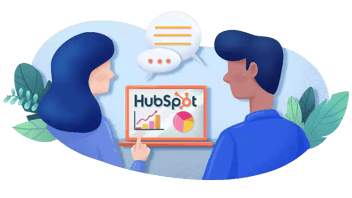What is the Purpose of a Landing Page? Best Practices in Marketing
Tired of website traffic that never turns into sales?
Landing pages might be the secret weapon you're missing. Your website shouldn't just attract traffic but also generate a steady stream of leads. Landing pages can be the key to unlocking this growth.
Let's dive into how landing pages work and how to craft one that transforms your business.

Why are Landing Pages Important?
-
Companies see a huge increase in leads with more landing pages. Companies with 31-40 landing pages generate 7x more leads than those with only 1 to 5 landing pages. And the numbers get even more impressive: businesses with over 40 landing pages generated a whopping 12 times more leads than those with only 1 to 5 landing pages. [HubSpot]
-
More than one in three marketing leaders cite conversion rates as a top KPI they prioritize tracking [HubSpot].
-
The average conversion rate of a landing page is 26%. 67% of all marketers achieve a conversion rate of over 10% for their landing pages. Less than 10% accomplish conversion levels of over 70%. [Email Vendor Selection]
-
Fast loading times are essential for holding attention. A mere 1-second delay in page load time can lead to a 7% reduction in conversions.[Think with Google]

What are Landing Pages?
A landing page is a focus tool designed for a specific marketing purpose. Essentially, it's a standalone web page created to guide visitors toward a particular action. What sets a landing page apart is its simplicity and directness, minimizing distractions to keep users focused on a singular goal. It's all about conversion rate optimization.
A landing page is a dedicated entry point, directing visitors from various sources like social media, email campaigns, search engine results, or Call-to-Actions (CTAs) on a website. Key features differentiate a landing page from other website pages. Notably, it lacks extensive navigation menus and external links, maintaining a straightforward design to keep the user's attention on the primary call to action. Landing pages are also tailored to match the source directing traffic, ensuring a consistent and coherent user experience.
A landing page is a specialized tool that captures attention, maintains focus, and drives specific user actions. Its clear-cut role makes it an essential asset for any successful digital marketing campaign.
What is a Landing Page Used For?
At the heart of every well-crafted landing page lies its core purpose – a singular objective that defines its existence within the digital marketing landscape. The fundamental goal of a landing page is to drive conversions. Whether it's encouraging visitors to purchase, fill out a form, or subscribe to a newsletter, the core purpose of a landing page is to guide users seamlessly toward a specific, predefined action.
Unlike broader website pages that may serve informational or navigational purposes, landing pages are strategically designed to be conversion-centric. They act as virtual gateways, ushering potential customers through the marketing funnel with precision and intent.
The primary focus on conversion is what sets landing pages apart. These pages streamline the user journey by eliminating unnecessary distractions and presenting a CTA, minimizing friction between interest and action. This intentional simplicity reduces cognitive load and guides users toward the desired outcome.
Here is an example of one of our CTAs. Clicking this button will automatically bring website visitors to the associated landing page (shown below), prompting them to fill out a form and get the download.

The core purpose of a landing page is inseparable from broader marketing objectives. No matter the type of landing page, whether part of a product launch, lead generation campaign, or promotional effort, landing pages are finely tuned to align with and amplify overarching marketing goals. This strategic alignment ensures that every aspect of the page – from design to messaging – works harmoniously to achieve the intended results.
The effectiveness of a landing page is often measured by its conversion rate – the percentage of visitors who complete the desired action. This metric provides valuable insights into the page's performance and is a crucial indicator of its success in meeting the core purpose. Continuous monitoring, analysis, and optimization are essential to ensure the landing page evolves with changing marketing dynamics and consumer behaviors.
Key Functions
1. Conversion Catalyst
The primary function of a landing page is to act as a conversion catalyst. Unlike generic web pages, a landing page is meticulously crafted to guide visitors toward a specific action, whether purchasing, signing up for a service, or downloading content. The focused nature of landing pages minimizes distractions, steering users directly toward the desired conversion goal.
-
Simplified user journey: Landing pages streamline the journey by eliminating unnecessary elements that might divert attention. A well-optimized landing page presents a clear value proposition and a compelling CTA, reducing friction between user interest and the ultimate conversion.
-
Optimized forms: For lead generation, landing pages often feature forms. These forms are carefully designed to gather essential information without overwhelming the visitor. Optimizing form length and clarity enhances the likelihood of successful conversions.
2. Lead Generation
Landing pages are pivotal in lead generation as dedicated hubs for capturing valuable customer information. By offering something of value in return – such as a whitepaper, webinar, or exclusive access – landing pages entice visitors to provide their details, expanding the potential pool of leads for future marketing efforts.
-
Incentivized offers: Effective lead generation relies on incentivized offers. Landing pages concisely communicate the offer's value, encouraging visitors to exchange their contact details for the promised content or service.
-
Strategic form placement: Placing lead capture forms strategically on landing pages is crucial. Whether it's above the fold or after a compelling product description, form placement impacts conversion rates. A balance between visibility and user experience is key.
3. Data Insights
Landing pages serve as invaluable data sources and insights, offering marketers a nuanced understanding of user behavior, preferences, and engagement levels.
-
Analytics integration: Marketers access a wealth of information by integrating analytics tools. Metrics such as bounce rates, time spent on a page, and conversion rates provide insights that inform strategic decision-making.
-
A/B testing opportunities: Landing pages facilitate A/B testing, allowing marketers to experiment with elements like headlines, imagery, or CTAs. Analyzing the performance of variations helps refine and optimize the page for maximum impact.
4. Trust and Credibility Building
Establishing trust is a critical aspect of successful online marketing. Landing pages contribute to building trust and credibility in several ways.
-
Consistent branding: A well-designed landing page reflects consistent branding, reinforcing brand identity and fostering trust. Consistency in messaging, imagery, and design elements across various marketing channels enhances credibility.
-
Social proof and testimonials: Including social proof, such as customer testimonials or user reviews, on landing pages adds authenticity and builds trust. Real-life experiences from satisfied customers instill confidence in potential buyers.
5. Nurturing Specific Campaigns
Landing pages are tailor-made for supporting and amplifying specific marketing campaigns, ensuring a cohesive and targeted approach.
-
Campaign alignment: Landing pages are crafted to align seamlessly with the theme and messaging of a particular campaign. Whether it's a product launch, seasonal promotion, or event registration, the landing page is an extension of the campaign.
-
Focused messaging: The focused nature of landing pages allows for precise messaging. Marketers can tailor content to address the target audience's specific needs and interests, increasing the campaign's relevance and impact.
Crafting an Effective Landing Page
Creating a landing page involves a delicate balance of design, copywriting, and user experience. In this chapter, we'll explore the key elements that contribute to crafting an effective landing page that captivates your audience and drives them toward the desired action.
Landing Page Design
The visual appeal of a landing page is paramount. A clean, uncluttered design enhances aesthetics and facilitates a seamless user experience.
-
Visual hierarchy: Establishing a clear visual hierarchy guides visitors through the page, directing their attention toward essential elements such as the headline, imagery, and call-to-action. This hierarchy ensures that visitors absorb crucial information in the intended order.
-
Consistent branding: Maintaining consistent branding elements, including colors, fonts, and imagery, fosters trust and reinforces brand identity. A cohesive design instills confidence in visitors and strengthens the connection between the landing page and your overall brand.
Copywriting
Crafting persuasive and concise copy is a cornerstone of effective landing pages. The messaging should be clear, compelling, and directly aligned with the intended action.
-
Clear value proposition: Communicate the value of your offer. Visitors should understand what they stand to gain from engaging with the landing page within seconds of arriving.
-
Conciseness: Keep the copy concise and to the point. Avoid unnecessary jargon or excessive details that might distract or overwhelm visitors. Every word should contribute to the overall clarity of the message.
Call-to-Action (CTA)
The CTA is the linchpin of a landing page, guiding users toward the ultimate conversion goal. Optimizing the CTA and establishing Call To Action Best Practices is essential for maximizing the effectiveness of your landing page.
-
Strategic placement: Position the CTA prominently on the page, ensuring it's visible without excessive scrolling. Strategic placement enhances the likelihood of user interaction.
-
Compelling language: Craft the CTA with compelling language that conveys urgency or emphasizes the benefit of taking action. Phrases like "Get Started Now" or "Unlock Your Exclusive Access" instill a sense of immediacy and value.
"Thank You" Page
Beyond the landing page itself, the post-engagement phase is equally crucial. Implementing a "Thank You" page after visitors complete the desired action, such as filling out a form or downloading content, adds significant value to the user experience.
-
Confirmation and appreciation: A "Thank You" page confirms that the user's action was successful. It conveys appreciation for their engagement, creating a positive interaction that enhances user satisfaction.
-
Next steps and additional information: This additional page can also provide the next steps or additional information. For example, if a user has subscribed to a newsletter, the "Thank You" page can include details about what to expect in upcoming newsletters or offer links to related content.
-
Encouraging further engagement: The "Thank You" page is an opportunity to encourage further engagement. Including social media links, related content suggestions, or invitations to explore other parts of your website keeps the user actively involved with your brand.

Above is an example of a "Thank You" page appearing after a website visitor has completed a form and taken the desired action.
Landing Page SEO
Search Engine Optimization (SEO) is the backbone of online visibility, and when it comes to landing pages, a strategic approach is crucial for maximizing their reach.
-
Keyword research and integration: Conduct thorough keyword research and strategically integrate relevant terms into the landing page's headline, content, and meta tags for improved visibility.
-
Optimized structure: Ensure a user-friendly URL structure, use header tags for content hierarchy, and employ clean formatting for both users and search engines.
-
Mobile responsiveness and speed: Prioritize mobile responsiveness, optimize load times, and leverage tools like CDNs to enhance the overall user experience and SEO performance.
Understanding and implementing effective landing page strategies are essential for success. After reading this blog, it should be clear that these digital entry points are not mere placeholders but dynamic tools that demand thoughtful consideration. From meticulous design principles and persuasive copywriting to strategic SEO integration and multichannel alignment, every facet contributes to the overall efficacy of a landing page.
This content is also available in:
- Deutsch: Was ist der Zweck einer Landing Page? Tipps für's Marketing
- Español: ¿Cuál es el objetivo de una landing page? Prácticas en marketing
- Français: Bonnes pratiques et l'objectif d'une page d'atterrissage ?
- Italiano: Qual è lo scopo di una Landing Page? Migliori pratiche di marketing
- Română: Landing Page: Scop și cele mai bune practici de marketing
- 简体中文: 着陆页的目的是什么?最佳营销实践










Leave a Comment